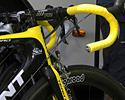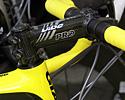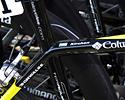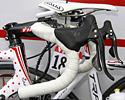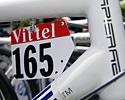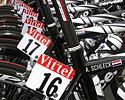
 |
 |
 |
 |
 |
 |
 |
 |
 |
 |
Race tech: Tour de France, July 12, 2008
Tour tech from Stage 7
By James Huang in Brioude, France
Team Columbia cracks out yellow-accented special for Kirchen
As we've now all come to expect, Team Columbia's Kim Kirchen wasn't going to set out on his first full day as race leader with just a yellow jersey to commemorate the occasion. His Giant TCR Advanced SL was standard issue componentry-wise but was suitably dressed in splashes of yellow on the seat stays, fork, head tube and top tube along with, of course, matching bar tape (sadly, Team Columbia apparently couldn't dig up a yellow saddle to complete the ensemble).
Since the teams obviously can't predict the future, though, how do they always seem completely prepared when luck strikes?
For Team Columbia and bike sponsor Giant, it's a matter of 'just in time' manufacturing at its best. According to Giant marketing manager Andrew Juskaitis, the company keeps a size run of unpainted frames at its European team headquarters in Bonn, Germany for just such an occasion. When duty calls, one of those frames is immediately finished in a pre-determined graphic scheme and then delivered to the team with enough time left over to slap on some components.
Given that Kirchen wrapped up stage 6 at about 5:20pm local time and stage 7 started at 1:10pm the next day, we're guessing at least one Giant employee was up awfully late that night and another made a long drive in the dark supplied with a lot of coffee (we certainly hope the same person wasn't asked to do both jobs).
Other companies prefer more of a shotgun approach. According to Specialized PR man Nic Sims, the official colors for the year's various races and categories are divulged early on in the year and the teams have a pretty decent idea which of their riders might nab a certain leader's category. Therefore, Specialized opts to have size runs of frames painted and ready to be built at a moment's notice well before the race even begins.
The list of coordinating equipment and accessories obviously varies. Kirchen went relatively low-key with a matching yellow helmet and some yellow-fringed Oakley Radars. At the other end of the spectrum, we're guessing the vision of Alberto Contador (Astana) covered from head to toe in pink at this year's Giro d'Italia (heck, SRAM even coughed up pink lever hoods) is still hanging with most of us.
And what becomes of those special edition bikes once they're no longer required? Juskaitis says those bikes are "often kept as mementos by the racer or sent back to one of the Giant sales offices as a showpiece."
Sims' response is similar: "We're supposed to get them back… with 'supposed to' being the operative phrase there."
Team mechanics get creative for one small formality
Year after year, one question always seems to pop up from our readers come Tour time: how are those pesky little number plates attached to the riders' bikes?
Given that the shape and size of the number plates don't seem to change much from year to year (or from race to race, for that matter) one would think that there would be a well-established system in place but that couldn't be further from the truth. While the numbers don't change much, the shapes and sizes of the bikes certainly do and each team seems to have its own twist on how to get the job done.
Option #1: Many top-end frames used to be fitted with just such a thing on the underside of the top tube up by the head tube yet they're become fewer and further between these days. Française des Jeux's Lapierre machines are still so-equipped, though, and the mechanics have devised a rather fancy machined aluminum doohickey (yes, we're using the technical term here) to keep the race commissaries happy. There's even a locknut to keep the number from rotating (heaven forbid the number should turn into an air brake) although an extra zip-tie never hurt as we found on Philippe Gilbert's rig.
Option #2: Race officials apparently aren't too picky as to where those numbers are located as many teams mount them way out back such as with CSC-Saxo Bank. Their mechanics use a rather simple, yet effective, piece of bent metal clamped between the rear brake and the frame. The number is then bolted on to this widget (another technical term) and the rider is good to go. In some cases we've seen, the team decides to get really fancy and build the same thing out of carbon fiber.
Option #3: Team Columbia opts for a dedicated holder cleverly secured to the rear of the seatpost (or integrated seatmast as the case may be) with a stout o-ring. We're not sure if this is something they came up themselves but it's an elegant solution nonetheless and it's easily transferred with no tools required (and based on what Giant has told us, Kirchen's mechanic needed to save every second possible). Silence-Lotto uses something similar but prefers the security of a zip-tie to strap it on.
Option #4: Ah, that lowly zip-tie. Always counted on and cursed when subject to failure yet never the recipient of deserved glory. When it comes to attaching number plates, three is apparently the lucky number for teams such as Milram and Quick.Step: simply trim the number to fit in the forward section of the front triangle, punch three holes and attach said zip ties. If the mechanic wants to earn bonus points, he'll even use flush cutters to trim the excess so that the rider's legs don't get slashed in mid-sprint. No muss, no fuss, job well done.
Photography
For a thumbnail gallery of these images, click here
Images by James Huang/Cyclingnews.com
- Kim Kirchen (Team Columbia) set out from Brioude aboard a suitably bright yellow machine to start the day.
- Yellow handlebar tape is in keeping with the yellow front end.
- Sadly, the saddle isn't yellow as well…
- …but the SwissStop brake pads are!
- Kirchen was equipped with deep-section wheels for stage 7.
- A PRO Vibe carbon stem dresses up the front end.
- Kirchen's bike is SRM-equipped…
- …and even the transmitters used during the Tour are now aero.
- How far will Kirchen go in this year's Tour de France?
- Cofidis rider Sylvain Chavanel started the day with this specially finished KOM Time but he finished the day one point behind new leader David De La Fuente (Saunier Duval-Scott).
- Chavanel's Time was littered with polka dots.
- Time's headset requires no compression plug to preload the bearings.
- A KOM bike should naturally be fitted with a lightweight saddle.
- White tape, black levers, red accents… anyone else see a trend here?
- More carbon is found in Chavanel's bottle cages.
- Chavanel ran Fulcrum RacingZero aluminum tubulars today.
- Lapierre's number holders are the only ones we saw that used a traditional top tube mount.
- CSC-Saxo Bank prefers a small bit of metal to get the job done…
- …while Team Columbia has its own little widgets mounted behind the seat tube.
- Who said it had to be fancy? Three zip ties work just fine for Barloworld.

